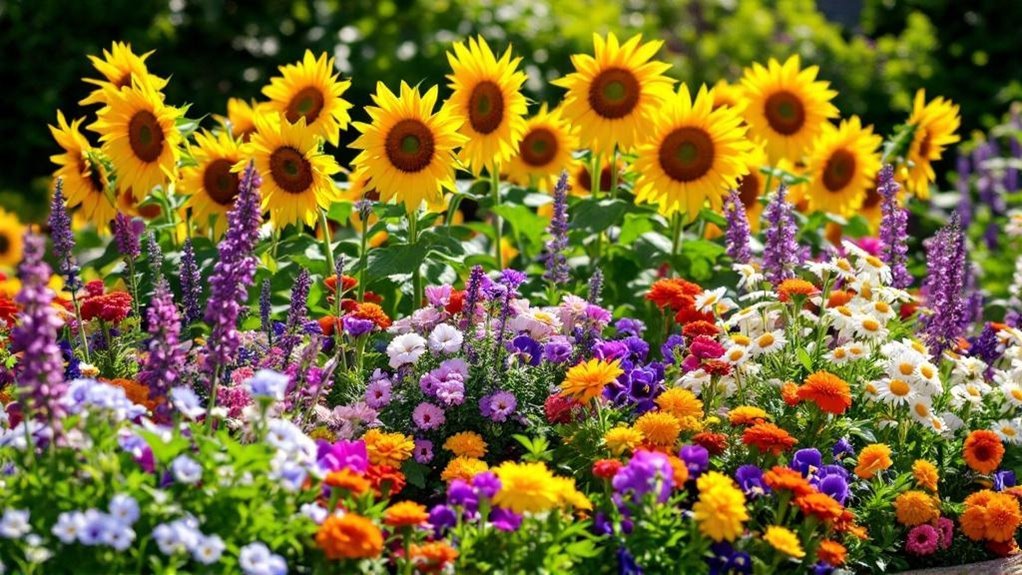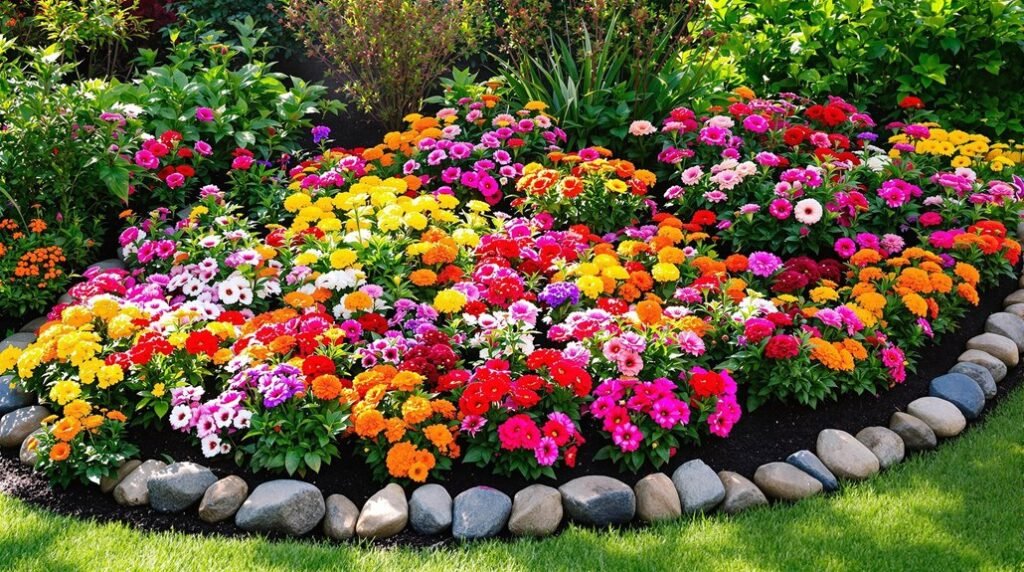Designing a flower bed is both an art and a science, blending creativity with practical planning. You might think a beautiful layout happens by chance, but it starts with careful choices about shape, plant selection, and arrangement. If you want your garden to look polished and thrive season after season, you’ll need to contemplate more than just picking pretty flowers. Let’s explore how to create a flower bed that’s as functional as it is visually appealing.
Planning Your Flower Bed Shape and Size
How should you shape and size your flower bed for the best results? Start by considering the overall garden design and decide if you want curved edges for a softer, natural look or straight edges for a structured feel—both affect the visual impact considerably.
Use a garden hose to outline potential shapes, which lets you adjust before committing. When planning your bed layout, keep the dimensions of your flower bed in mind: aim for at least two feet wide and about three feet deep to provide adequate space for plants and easy maintenance.
For planting using a layered effect, place taller plants at the back, medium ones in the middle, and shortest in front. This arrangement enhances depth and interest, making your flower bed both beautiful and practical.
Selecting Plants for Local Growing Conditions
When selecting plants for your flower bed, start by identifying your USDA Hardiness Zone to guarantee they can withstand local climate extremes. Conduct a soil test to learn about pH and nutrient levels, matching plants to your soil type. Note the light exposure in your garden space—full sun, partial, or shade—and choose plants that thrive accordingly. Consider moisture levels and rainfall to avoid over- or under-watering. Incorporate native plants, which adapt well to local growing conditions and support local ecosystems. Mix annual plants for seasonal color and variety.
| Factor | Consideration | Example |
|---|---|---|
| USDA Zone | Climate tolerance | Zone 5: Cold hardy |
| Soil Type | pH, nutrients | Loamy, sandy, clay |
| Light Exposure | Full sun, shade | Sun-loving or shade-tolerant |
| Moisture Levels | Drainage, rainfall | Wet, dry, moderate |
| Plant Type | Native, annual | Coneflower, marigold |
Arranging Plants by Height and Grouping

Although arranging plants by height might seem straightforward, it plays a crucial role in showcasing each plant’s beauty.
Start by placing tall plants at the back, medium-height in the middle, and short ones at the front to create a visually appealing layout.
When you group perennials, use odd-numbered groupings like 3, 5, or 7 to achieve a natural look that enhances your dynamic garden design.
Be mindful of proper spacing, giving each plant enough room based on its mature size to prevent overcrowding.
Also, consider the bloom time and color of each plant in your clusters to maintain a rhythmic flow of colors throughout the season.
This thoughtful approach to arranging plants by height and grouping guarantees harmony and vibrancy in your flower bed.
Preparing Soil and Improving Plant Health
Since healthy soil forms the foundation for vibrant flower beds, you should start by testing your soil’s composition and nutrient levels. Aim for a pH between 6.0 and 7.0 to optimize plant health.
When preparing soil, add organic amendments like compost or aged manure to improve soil structure and boost fertility. Good drainage is essential; sandy soils drain well, but clay soils benefit from added organic matter to enhance aeration. Consider the no-till method by layering cardboard or newspaper to suppress weeds and maintain soil integrity. Regularly monitor soil moisture and adjust your irrigation practices to avoid overwatering or underwatering, which can stress plants. Investing in a reliable soil testing kit can provide essential insights into your soil’s nutrient levels and help tailor your amendments effectively.
Maintaining Seasonal Interest and Color Rhythm

To keep your flower bed vibrant all season, you’ll want to choose plants that bloom at different times, ensuring color never fades completely.
To maintain your garden’s seasonal interest, select a wide variety of plants that bloom throughout spring, summer, and fall. Combine perennials for reliable returns with annuals to refresh your flower garden annually.
Choose diverse blooms across seasons, mixing perennials and annuals for vibrant, ever-changing garden color.
Group different plants in odd numbers—3, 5, or 7—to create strong visual impact and enhance color rhythm. Vary plant heights and textures to add depth and keep your garden dynamic as seasons shift.
Make it a habit to observe your garden regularly, noting bloom times and gaps. This way, you can fine-tune your plant choices each year to sustain continuous color rhythm and lasting seasonal interest.
Utilizing Pre-Planned Gardens and Design Resources
When you want a beautiful flower bed without the guesswork, pre-planned gardens offer a clear, step-by-step planting diagram that guides you through soil preparation, plant placement, and care.
These design resources help you achieve professional aesthetics with ease, even if you’re new to gardening. By selecting plants that would thrive locally, you promote successful growth and reduce maintenance.
Many platforms provide customizable gardens, letting you tailor layouts to your style while guaranteeing visual harmony.
Benefits of using pre-planned gardens include:
- Simplified soil preparation and planting steps
- Expertly curated plants that support healthy growth
- Cohesive designs that enhance flower beds’ overall appeal
Leveraging these tools guarantees your garden looks polished and flourishes beautifully.
Frequently Asked Questions
How to Make Flower Beds Look Professional?
You’ll create professional-looking flower beds by grouping plants in odd numbers, spacing them properly, layering heights, and maintaining clean edges. Regularly assess your garden to fill gaps and keep everything vibrant and organized.
What Is the 70/30 Rule in Gardening?
You might think mixing plants is tricky, but the 70/30 rule makes it easy. You plant 70% perennials for lasting beauty and 30% annuals for seasonal color, keeping your garden vibrant and low-maintenance year-round.
How to Plan Your Flower Bed Layout?
You should outline your bed with a garden hose, pick a three-foot depth, group native plants in odd numbers, check sunlight patterns, and space plants properly to guarantee healthy growth and a visually appealing layout.
What Is the Rule of 3 in Landscaping?
The Rule of 3 in landscaping means you group plants in odd numbers, especially threes, to create balance and visual interest. You’ll find your garden looks more natural and appealing, with stronger focal points drawing attention.
Final Thoughts
By sketching your flower bed’s shape with a garden hose, you’ll gently trace the canvas for your living masterpiece. Choosing plants that thrive locally and layering them by height lets your garden whisper stories in vibrant hues. Grouping blooms in odd numbers creates a natural rhythm, while thoughtful soil prep guarantees a lush foundation. With these subtle strokes, you’ll paint a garden that gracefully dances through the seasons, inviting beauty and calm into your outdoor space.
